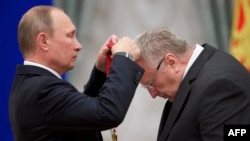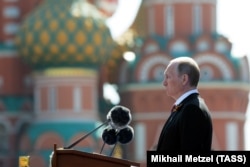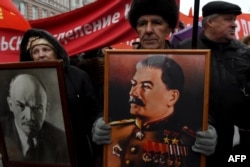Even for flamboyant firebrand Vladimir Zhirinovsky, the remarks seemed strikingly provocative: "God save the tsar!" he said, raising his hands high in an ornate Kremlin hall where President Vladimir Putin had just hung an eagle-and-cross Service to the Fatherland medal around his neck. "Reign for our glory, reign to strike fear in our foes, Orthodox tsar. God save the tsar!"
Putin's reaction is not visible in footage from the ceremony on September 22, four days after tightly controlled elections handed the loyal United Russia party more seats that ever before in the State Duma -- easily enough to pass a constitutional amendment abolishing presidential term limits, should Putin seek to stay in power for life.
But whether Zhirinovsky quoted from an imperial-era national anthem off the cuff or under orders from the Kremlin, his outburst neatly complemented an image Putin seems to have cultivated assiduously over 17 years in power -- that of a Russian tsar.
The image-making is evident in words and actions both large and small, from his sumptuous surroundings in the Kremlin and a lavish Sochi summer headquarters to surprise decrees and dismissals, as well as efforts -- such as an hourslong annual call-in show -- to cast himself as the only hope for everyday Russians beleaguered by craven tycoons and indifferent bureaucrats.
Abroad he has also acted with a tsarlike assertiveness, particularly in his third term, seizing Crimea from Ukraine -- a move he claimed righted a historical wrong by restoring Russian control over a region previously annexed by Empress Catherine the Great, in the 18th century -- and challenging Western leaders while seeking to bolster Moscow's power in Europe and beyond.
The Empire's Glaring Flaw
But the picture of Putin as a tsar has one glaring flaw, and it's plainly visible at the heart of Russia: The embalmed corpse of Vladimir Lenin, whose seizure of power following the Bolshevik Revolution sealed the fate of the Romanov dynasty and ushered in more than 70 years of communist rule, lies on view in a squat stone mausoleum just outside the Kremlin walls.
Visited by tourists from the Russian provinces and the rest of the world, the tomb on Red Square is a stark reminder of a big break in any line drawn from the Russian tsars to Putin, who was born smack in the middle of the Soviet era -- in a city that then bore Lenin's name -- and served for 16 years as an officer of the KGB.
The blot Lenin's body places on Putin's image as a tsar is particularly obvious every year on May 9, when the mausoleum is hidden from view as the president addresses a military parade commemorating what for many Russians is the proudest moment of the troubled Soviet era -- the defeat of Nazi Germany in World War II.
Putin has drawn on aspects of both the tsarist and Soviet eras in his efforts to shape Russia. Many critics accuse him of echoing practices of Soviet times -- and even of dictator Josef Stalin -- in his quest to tighten his grip over Russia.
But he has done more to link his image to the long history of tsars than to the relatively brief, badly checkered Soviet experiment -- seven oppressive decades that began with the kind of upheaval Putin seems bent on ensuring does not threaten his rule.
"We've seen a long-term buildup of the sense that the real model is to be found not so much in the Soviet times, but actually in tsarist times," says analyst Mark Galeotti, a senior policy fellow at the Institute of International Relations in Prague.
"And I can't help but wonder if while once upon a time Putin was willing to say that the collapse of the Soviet Union was the greatest geopolitical catastrophe of the 20th century, he might well now actually be saying that 1917 was," Galeotti adds.
Time To Consign Soviet Era To History?
Amid intermittent calls from Russians to put Lenin in the ground, Putin -- who is often described as pragmatic -- may have been weighing the possibility for years. And 2017, the centenary of the revolution, would seem like the time to do it.
For one thing, burying Lenin could drive home the message that revolution is bad.
He criticized Lenin last January, accusing him of planting a "time bomb" beneath the state and sharply denouncing brutal repressions by the Bolshevik government.
Others have gone further. Natalia Poklonskaya, a Russian lawmaker and former prosecutor in the Russian-imposed government of Crimea, lumped Lenin together with Hitler and Mao Zedong as "monsters" of the 20th century. And ultranationalist Zhirinovsky has called for Moscow's Leninsky Prospekt -- Lenin Avenue -- to be renamed after Ivan the Terrible.
In a reference to the Bolshevik Revolution during his state-of-the-nation address on December 1, Putin said that coups invariably lead to "the loss of human life, casualties, economic decline, and misery." He warned against "speculating on tragedies that occurred in nearly every Russian family" as a result of the revolution -- a warning, at least in part, not to try anything like it again.
No Regime Change Here
Putin's fear of revolution appears to be rooted partly in his dismay at the protests that have brought down governments in the former Soviet republics of Georgia, Kyrgyzstan, and Ukraine in the past 13 years -- political change that he accuses the United States of fomenting.
Analysts say he was rattled by the big street protests that erupted in Moscow over widespread evidence of fraud in a December 2011 parliamentary elections and anger over his plan to return to the presidency after four years as prime minister.
Putin weathered those protests and, back in the Kremlin in May 2012 for a six-year term, swiftly took steps to narrow the scope for street demonstrations and clamp down on dissent. Now he is gearing up for the next presidential election, due in March 2018.
Putin is widely expected to run and to win. But the future will be clouded from the moment he takes the oath, because the constitution bars him from seeking a third straight term in 2024, when he will be 71.
At the very least, burying Lenin months before the election would inject a jolt of energy into the tightly controlled political process.
It could also help Putin dispel a potential future threat from the Communist Party, which Galeotti says is the only major independent political machine in Putin's Russia and may be revitalized by a new generation of leaders and supporters. "It makes a statement that the Kremlin is in charge and is moving forward, and that it's time to forget the past," he explains.
More broadly, burying Lenin would add substantially to Putin's legacy, etching him in history as a leader who made a big break with the Soviet past. It could help him replace Lenin as a father figure and aid his quest to unite Russian citizens around some overarching national idea -- a goal that has so far been elusive.
And on a practical, political level, it could help pave the way for a constitutional change or some less formal arrangement that would keep him in power past 2024. Or, if Putin prefers to step off center stage and help Russia forge a political system more reliant on institutions than on a single ruler, removing Lenin would give that process a symbolic boost.
Communist Martyr?
But it could be risky.
There have been calls for Lenin's burial since the Soviet Union fell apart in 1991. In 2013, a poll by the independent Levada Center found that only 25 percent of Russians believed his body should remain in the mausoleum on Red Square.
But the Kremlin has always been cautious, concerned about offending those who feel nostalgia for the Soviet era and about angering the Communists -- who have come in second in every parliamentary election since 1995, when they came in first.
Just as the Bolsheviks feared that revealing the location where the bodies of Tsar Nicholas II and his family were dumped after they were shot in a provincial cellar in 1918 would give them posthumous power as martyrs and spark protests, post-Soviet leaders have worried that moving Lenin's body from its prominent place could give leftist Kremlin opponents more force and focus.
Putin will want to avoid any step that would "unleash forces that are going to get out of control very fast," Anna Arutunyan, author of the book The Putin Mystique: Inside Russia's Power Cult, said in a Power Vertical Podcast on RFE/RL in November. "Such an emotional thing as this -- it could actually backfire in terms of creating more support for the Communist Party instead of less."
Galeotti believes, however, that Putin's government could seek to put paid to such a threat -- and also clear the body off Red Square -- by publicly casting his burial as a "final gesture of respect" for a man who played a crucial role in Russian history, good or bad.
But as 2017 approached, Russian officials made it clear that Putin plans to use the 100th anniversary of the Bolshevik Revolution as an occasion to plug the idea of national unity. While Putin may see Lenin's burial as a chance to do just that, he could also decide that Russia is still not ready for such a step.
"There is this backlash against Lenin, but he is still in the mausoleum, and I'm not really seeing him being taken out of the mausoleum any time soon," Arutunyan said.
















